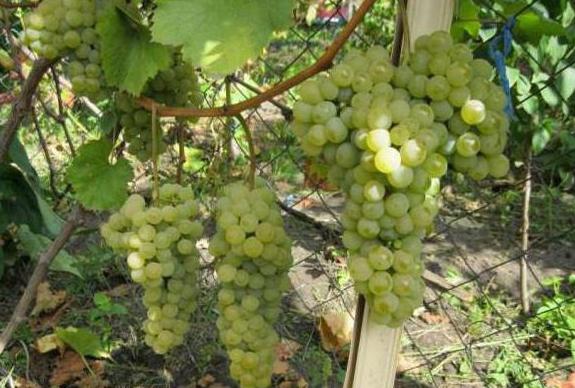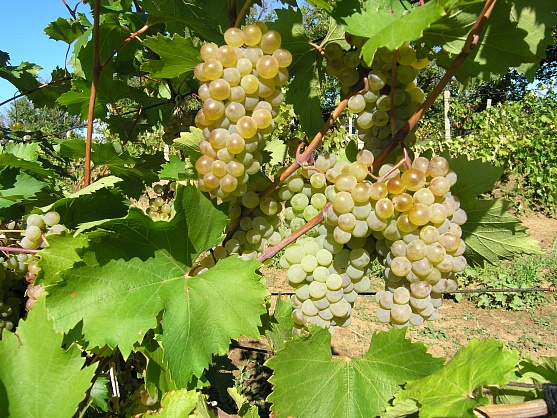For those who grow grapes and are interested in new products, a variety with the name "Magaracha" has recently been bred. Variety culture is famous for its rich harvest, while the quality of the fruit is at a decent level. Magaracha is loved and grown in the southern part of the country, every year grapes gain new fans.
Description and specifications
 In Yalta, with the same name of the variety, there is an institute that is engaged in the cultivation of grapes. There grapes were selected by merging the beloved and famous Kishmish with other varieties. Scientists aimed at obtaining a technical grape variety, early Magaracha met all the requirements. The yield of the variety is stable and high. Grapes enter fruiting no later than the third year after planting; they do not need pollinators. By 6-8 year of cultivation, the yield indicator reaches 120 centners per hectare. Subject to the correct agro-cultivation technique, the value reaches 150 centners.
In Yalta, with the same name of the variety, there is an institute that is engaged in the cultivation of grapes. There grapes were selected by merging the beloved and famous Kishmish with other varieties. Scientists aimed at obtaining a technical grape variety, early Magaracha met all the requirements. The yield of the variety is stable and high. Grapes enter fruiting no later than the third year after planting; they do not need pollinators. By 6-8 year of cultivation, the yield indicator reaches 120 centners per hectare. Subject to the correct agro-cultivation technique, the value reaches 150 centners.
Ripening period is short: only 115-120 days from the onset of kidney formation. Most of the harvest ripens by the end of August, so the grapes are also called early in a different way. The resulting berries are purple-black with a matte skin. The pulp is reddish in color, juicy and with a nutmeg aroma. There are 2-3 seeds in the pulp. The shape of the fruits is round, light weight - 4-5 g. The grapes are sweet and sour to taste, the amount of sugars is 15-16%, the acidity is 6 g / l. Tasteful assessment of experts - 8 points out of 10. Berries are picked in heavy clusters weighing up to half a kilogram. Bunches are prone to shedding if too many fruits have formed.
Magaracha is grown for winemaking. A great wine is obtained from the variety; it is possible to make strong alcoholic drinks. Magaracha is used for cooking jam, jams, confiture. Berries can be eaten, they will appeal to those who love a sour taste.
The variety has good frost resistance up to -18 degrees. You can grow in the central region of the country and in the southern part. Magaracha is especially well established on the Crimean peninsula, the Krasnodar Territory, Kazakhstan, Azerbaijan, and Moldova.The variety loves the sun, warm and humid air, so planting in a warm zone is preferred for him. Grapes are grown on sandstones with loamy soil, before planting, for the best growth, the soil must be removed.
The immune qualities of Magarachi are average. High probability of infection with mildew, phylloxera, black spotting. Pests and insects sometimes attack berries. Treatment with fungicidal preparations and insecticides is mandatory at least 2 times per season.
The positive qualities of Magarachi are:
- high productivity;
- the transportability and keeping quality of berries;
- the possibility of reproduction;
- unpretentious care.
The disadvantages include poor tolerance of diseases and a tendency to shed berries.
Landing
 Planting of Magarachi is carried out in late spring or early summer in the central region of the country, in the southern part seedlings are planted in open ground in mid-April. The soil for the culture is prepared in the fall: humus and compost are added at the rate of 10 kg per 1 sq. M of land. The pit is prepared in advance, its depth should be at least 80 cm.Small crushed stone is laid at the bottom, then a bucket of humus, a glass of ash and 100-200 g of superphosphate are added. The pit is well watered and the soil is left to settle until spring. During the winter, nutrients in the earth will disperse well, so the soil will become fertile.
Planting of Magarachi is carried out in late spring or early summer in the central region of the country, in the southern part seedlings are planted in open ground in mid-April. The soil for the culture is prepared in the fall: humus and compost are added at the rate of 10 kg per 1 sq. M of land. The pit is prepared in advance, its depth should be at least 80 cm.Small crushed stone is laid at the bottom, then a bucket of humus, a glass of ash and 100-200 g of superphosphate are added. The pit is well watered and the soil is left to settle until spring. During the winter, nutrients in the earth will disperse well, so the soil will become fertile.
Before planting, seedlings are treated in a disinfectant solution of potassium permanganate, and then the roots are lowered into a pit and sprinkled with earth. Healthy plants take root in a couple of weeks, and by the end of summer the length of the vine will reach 2 meters. A distance of 2.5-3 meters recedes between neighboring seedlings. After planting, the plants are watered with clean water (20 liters per 1 bush) and mulch the soil with sawdust.
Care
Magarachei will not need special care. At the beginning of cultivation, the plant is intensely gaining strength, its shoots develop and lengthen. In the fall, they trim the bush. They wait until all the leaves fall off the branches, cut off the diseased and dry branches. Of all the formed buds, only 10-12 are left; for fruiting next year, this is quite enough. Cut branches on young grapes need a little higher than the location of the kidney. The cut places are poured with garden varieties or treated with potassium permanganate.
Watering the grapes is rare and is carried out 3-4 times for the entire growing season: before flowering, after flowering, after fruiting. About 1 time per month, the culture is watered with cool water. For convenience, a groove up to 10 cm deep is dug around the trunk. Water is poured into the groove and wait until it is absorbed. Such irrigation prevents soil acidification, and water flows directly to the root system.
Shelter for the winter
In the south, it is not necessary to cover the variety for the winter, even during the first wintering of grapes. For other areas, grapes have been prepared for wintering since the beginning of November. The vine is removed from the trellis and instilled into the mulch. Spruce spruce branches or autumn leaves are placed on top of the mulch. On the leaves with branches throw a waterproof film. At the corners of the film they put a load so that it is not blown away by the wind. Open grapes not earlier than the beginning of April.
Reviews
Ivan from the Kemerovo region
“I bought seedlings 3 years ago, now their height is about 5 meters. The berries ripened by mid-September. Processed grapes in spring with a 3% solution of Bordeaux fluid, the plants were not sick. Before flowering, he still processed Topaz. The inflorescences are intertwined, be sure to plant the vine and untangle the clusters, otherwise it is practically impossible to do it later. ”
Marina from the Krasnodar Territory
“The fruits of Magarachi are good for making homemade wine. There is not much sugar in the berries, the first fruits ripen with the sweetest. Those berries that are removed last taste sour. "They like wasps to Magaracha so that insects do not fly, use insecticides such as Chlorophos, the Delta zone or special traps for insects."




 Non-covering winter-hardy grape varieties for Moscow region
Non-covering winter-hardy grape varieties for Moscow region How to keep the vine in winter
How to keep the vine in winter When can I transfer grapes to another place in the fall
When can I transfer grapes to another place in the fall How to cover and prepare grapes for the winter in the suburbs
How to cover and prepare grapes for the winter in the suburbs